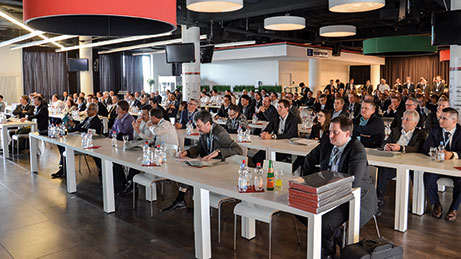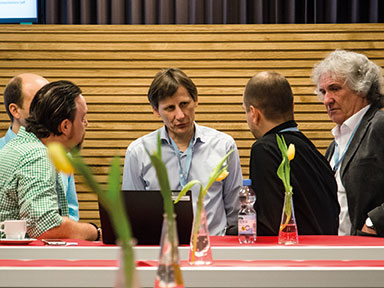
More than 200 users of CADENAS technology gathered in Augsburg, Germany in March 2017 for the 18th annual CADENAS Industry Forum. Image courtesy of CADENAS.
Latest News
April 6, 2017
If a team of engineering students from Ryerson University in Toronto has anything to say about it, the first Hyperloop transit systems to go into commercial use will be built with off-the-shelf aircraft landing gear for “take-off” and “landing” in the vacuum environment envisioned by Elon Musk and others as a “fifth mode of transport” for people and goods.
The team assumed the task of designing the Hyperloop wheel system as part of a SpaceX Hyperloop competition. The wheels had to be capable of supporting 180 mph start and stops, and be available for emergency service. The rest of the time, while the Hyperloop capsule travels at 700 mph through an intercity tube, the wheels must be retracted.
As explained by Graeme Klim at the recent CADENAS Industry Forum in Augsburg, Germany, the Ryerson team saw specific advantages in saving manufacturing time and costs by specifying existing aircraft parts. They used Aerospace Industries Association (AIA) specs, and searched through a library of 3D CAD models from landing gear assemblies that met National Aeronautics Standards. Their search—powered by CADENAS technology—helped the team to quickly identify a suitable wheel system already on the market from IHS Markit. The landing gear they chose had eight subassemblies, 42 custom designed parts, 162 standard parts and 204 total parts.
Klim estimates the team saved 58% of the time it would have taken to design a similar gear without access to the PARTsolutions database. “Our use of AIA/NAS parts accelerated design times,” says Klim. “Using it lets innovators focus on key design components, rather than creating standards parts.” Their efforts won them first prize in the subassembly division of the competition.
 More than 200 users of CADENAS technology gathered in Augsburg, Germany in March 2017 for the 18th annual CADENAS Industry Forum. Image courtesy of CADENAS.
More than 200 users of CADENAS technology gathered in Augsburg, Germany in March 2017 for the 18th annual CADENAS Industry Forum. Image courtesy of CADENAS.The Ryerson team credits the use of CADENAS technology as a key to success in its hyperloop project. Yet, at the heart of it, the subject at hand is a data management issue—and engineers have been known to fall asleep at the mere mention of tasks that feel more like record-keeping than creating and testing.
Managing Parts Data
Knowing such dread can prevent efficiencies in cost and time to market has given CADENAS an edge in the marketplace for 25 years. The Ryerson University team was one of many at the CADENAS Industry Forum who gathered in Augsburg to learn—from each other and from the company—the latest in design and engineering efficiency through better use and management of parts data.
CADENAS has two lines of business, each with its own corporate structure. PARTsolutions is led by co-founder Jürgen Heimbach; it offers software for strategic management of components and standard parts. PARTsolutions claims 70% of controllable overall product costs can be traced back to planning in the product development phase, and offers a variety of tools and processes to help companies optimize the complete specify-purchase-manufacture process.
 Jürgen Heimbach, CEO of CADENAS GmbH, gave the opening keynote at the annual Industry Forum event in Augsburg, Germany. Image courtesy of CADENAS.
Jürgen Heimbach, CEO of CADENAS GmbH, gave the opening keynote at the annual Industry Forum event in Augsburg, Germany. Image courtesy of CADENAS.The other half of CADENAS is eCATALOGsolutions, led by co-founder Tim Thomas; it offers automated parts catalog solutions for manufacturers of technical products, and hosts a community parts portal site (CADENAS PARTcommunity). This half of CADENAS claims 86% of 3D CAD part models downloaded from a community site or catalog ends up being purchased for a new product.
PARTsolutions is the internal solution for managing design using existing parts; eCATALOGsolutions is the external engine that provides an automated process for procurement. It was not that long ago the company described its work as providing a “single authoritative source” for improving CAD, PLM (product lifecycle management) and ERP (enterprise resource planning) operations by streamlining part management and use. “We would tell people, ‘throw out the tools and look at the processes,’” says Thomas. “Companies have terrible processes and waste a lot of time and money; they don’t reuse parts nearly enough.” But today CADENAS sees a new market opportunity in bringing parts efficiency to the next wave of digitalization, which many call Industry 4.0 and/or the Internet of Things (IoT). The more that individual components need to communicate with each other and with other systems, the more intelligent the digital data must be at the product development stage.
Enabling the Digital Twin
To bring full digitalization to manufacturing requires the use of a digital twin, a 3D CAD model that is linked to the physical instantiation of design. One of the conference themes was how companies are already using CADENAS parts management technology to make the digitalization transformation.
WAGO is a German manufacturer of fasteners, switches and related parts, from micro to building size. They provide customers with an online CADENAS-powered catalog that creates a fully digital supply chain.
“We provide a continuous process chain from planning to the realization of the digital twin,” says WAGO’s Simone Brinkmann-Tewes. The service WAGO offers extends beyond the 3D geometry and the PMI to analysis data, giving what Brinkmann-Tewes describes as “plausability checking” in the earliest design stages.
The parts in the WAGO catalog are available in “all possible [CAD] formats” due to CADENAS PARTsolutions built-in conversion and multi-CAD cataloging. WAGO saves time and protects its IP by only sharing a minimal level of detail during the browsing phase. Customers can easily “drill down” for the full details. WAGO now has 60,000 products in its catalog system, and logged more than 470,000 downloads in 2016.
Both divisions of CADENAS see their mission as bringing order to three types of parts: company standard, industry standard and commercial standard. “You don’t get paid to model industry and commercial standard parts,” Thomas notes. “Yet all standard parts are crucial.”
 Networking with colleagues was a key feature of the CADENAS Industry FORUM. Breaks between presentations were longer than at similar conferences, allowing for more interaction between attendees. Image courtesy of CADENAS.
Networking with colleagues was a key feature of the CADENAS Industry FORUM. Breaks between presentations were longer than at similar conferences, allowing for more interaction between attendees. Image courtesy of CADENAS.Other users speaking at the conference echoed the refrain. Matthew Krupa of Parker Hannifin explained how his company ended mountains of data duplication, in which the same part—or functional duplicates—were appearing up to 20 times in various internal databases. As a leading manufacturer of parts to control flow and facilitate motion for liquids and gases, internal parts management is ran as an internal reseller. It must support more than 3,000 engineers using either Dassault Systemès Catia or Autodesk Inventor CAD systems as well as Dassault Enovia and Autodesk Vault data management systems.
Using CADENAS technology, Parker Hannifin indexed every part geometrically to weed out duplicates without having to rely on poorly crafted part names. “This system gives us new opportunity to eliminate duplication of effort,” Krupa says, adding that the company identifies three specific best practices it has implemented as a result of adopting CADENAS technology:
- A global catalog in HQ data center to promote use of single part number with internal tracking
- Allowing for divisional part numbers (necessary due to longstanding internal culture issues)
- Creation and use of a native indexing system for standard Parker components
Wolf Verpackungsmaschinen GmbH streamlines the search for existing parts with CADENAS Sketch Search technology. “A technician says ‘I need this kind of part with this angle and these drill holes,’” says Wolf’s Marco Kobylka. A typical search like this finds 20-30 likely matches, which can be quickly reduced through a secondary search. “We would spend 48 hours looking for parts” at times, Kobylka says. “11% of our measured time was part search before we installed CADENAS.”
LUCAS France specializes in manufacture of parts for industrial robotics. It has installed a custom, interactive parts configurator for clients, and can even provide the BOM details from selected parts in a format suitable for direct input to ERP. “We have received very positive reaction to our configurator,” says Stèphane Lucas. “We think, ‘Are we the only ones doing this?’”
Subscribe to our FREE magazine, FREE email newsletters or both!
Latest News
About the Author
Randall S. Newton is principal analyst at Consilia Vektor, covering engineering technology. He has been part of the computer graphics industry in a variety of roles since 1985.
Follow DE





